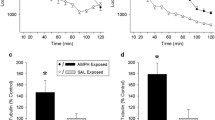Abstract
We investigated whether pharmacological effects of the dopamine agonist apomorphine can be conditioned by establishing an association of apomorphine administration with exteroceptive cues. Apomorphine was repeatedly administered and subsequently, the rat was put into a test cage and exposed to an acoustic and an olfactory stimulus (“conditioned rats”). Control animals (“pseudoconditioned” rats) were treated with the same pharmacological schedule of apomorphine not temporally associated with the stimuli. On the test day, both groups were injected with saline and exposed to the stimuli described.
The stereotyped behaviour produced by large doses of apomorphine (0.5 or 2.0 mg/kg SC), namely sniffing, licking and gnawing, could be conditioned in a pronounced way. During the conditioning period, a change in the stereotypies was observed with regard to the time-course (earlier occurrence) and to the character of the stereotypies (from sniffing to licking and gnawing), when 0.5 mg/kg apomorphine was used, but not with the dose of 2.0 mg/kg. The conditioned responses showed a relatively uniform distribution during the observation period with some increase towards the end of the observation period. Some signs produced by a low dose of apomorphine (0.07 mg/kg SC), namely hypomotility and ptosis, but not yawning, could also be conditioned, although in a less pronounced way. An intermediate dose of apomorphine (0.18 mg/kg SC) produced both signs observed after large doses and those observed after a small dose, occurring alternatingly. Both types of signs could be conditioned using this dosage. Conditioning did not alter striatal or mesolimbic dopamine turnover.
These results suggest that only behavioural signs due to an activation of postsynaptic dopamine receptors, but also some symptoms produced by an activation of dopamine autoreceptors can be conditioned.
Similar content being viewed by others
References
Abercombie ED, Jacobs BL (1985) Dopaminergic modulation of sensory responses of striatal neurons: single unit studies. Brain Res 358:27–33
Andén NE, Rubensson A, Fuxe K, Hökfelt T (1967) Evidence of dopamine receptor stimulation by apomorphine. J Pharm Pharmacol 19:627–629
Barr GA, Sharpless NS, Cooper S, Schiff SR, Paredes W, Bridger WH (1983) Classical conditioning, decay and extinction of cocaine-induced hyperactivity and stereotypy. Life Sci 33:1341–1351
Broekkamp CLE, Pijnenburg AJJ, Van Rossum JM (1973) Dopaminergic transmission in relation to mechanisms underlying stereotyped behaviour. In: Usdin E, Snyder SH (eds) Frontiers in catecholamine research. Pergamon, New York, pp 675–676
Carlsson A (1975) Receptor-mediated control of dopamine metabolism. In: Usdin E, Bunney WE (eds) Pre- and postsynaptic receptors. Marcel Dekker, New York, pp 49–53
Cools AR, Broekkamp CLE, Van Rossum JM (1977) Subcutaneous injections of apomorphine, stimulus generalization and conditioning: serious pitfalls for the examiner using apomorphine as a tool. Pharmacol Biochem Behav 6:705–708
Costall B, Naylor RJ (1973) The role of telencephalic dopaminergic systems in the mediation of apomorphine-stereotyped behaviour. Eur J Pharmacol 24:8–24
Dourish CT, Cooper SJ, Philips SR (1985) Yawning elicited by systemic and intrastriatal injection of piribedil and apomorphine in the rat. Psychopharmacology 86:175–181
Eikelboom R, Stewart J (1982) Conditioning of drug-induced physiological responses. Psychol Rev 89:507–528
Ellinwood EN jr (1971) Accidental conditioning with chronic methamphetamine intoxication: implications for a theory of drug habituation. Psychopharmacology 21:131–138
Ernst AM (1967) Mode of action of apomorphine and dexamphetamine in gnawing compulsion in rats. Psychopharmacology 10:316–323
Freed CR, Yamamoto BK (1985) Regional brain dopamine metabolism: a marker for the speed, direction, and posture of moving animals. Science 229:62–65
Havemann U, Magnus B, Möller HG, Kuschinsky K (1986) Individual and morphological differences in the behavioural response to apomorphine in rats. Psychopharmacology 90:40–48
Iversen SD (1983) Brain endorphins and reward function: some thoughts and speculations. In: Smith JE, Lane JD (eds) The neurobiology of opiate reward processes. Elsevier Biomedical, Amsterdam, pp 439–468
Kelly PH, Seviour PW, Iversen SD (1975) Amphetamine and apomorphine responses in the rat following 6-OHDA lesions of the nucleus accumbens septi and corpus striatum. Brain Res 94:507–522
Ljungberg T, Ungerstedt U (1977) Different behavioural patterns induced by apomorphine: evidence that the method of administration determines the behavioural response in the drug. Eur J Pharmacol 46:41–50
Maj J, Grabowska M, Gajda L (1972) Effect of apomorphine on motility in rats. Eur J Pharmacol 17:208–214
Melzacka M, Nesselhut T, Havemann U, Vetulani J, Kuschinsky K (1985) Pharmacokinetics of morphine in striatum and nucleus accumbens: relationship to pharmacological actions. Pharmacol Biochem Behav 23:295–301
Mogilnicka E, Klimek V (1977) Drugs affecting dopamine neurons and yawning behaviour. Pharmacol Biochem Behav 7:303–305
Robbins TW (1976) Relationship between reward — enhancing and stereotypical effects of psychomotor stimulant drugs. Nature 264:57–59
Schiff SR (1982) Conditioned dopaminergic activity. Biol Psychiatry 17:135–154
Serra G, Collu M, Loddo S, Celasco G, Gessa GL (1983) Hypophysectomy prevents yawning and penile erection but not hypomotility induced by apomorphine. Pharmacol Biochem Behav 19:917–919
Siegel S, MacRae J (1984) Environmental specificity to tolerance. Trends Neurosci 7:140–143
Ungerstedt U (1979) Central dopamine mechanisms and unconditioned behaviour. In: Horn AS, Korf J, Westerink BHC (eds) The neurobiology of dopamine. Academic, London New York San Francisco, pp 577–596
Westerink BHC, Korf J (1976) Turnover of acid dopamine metabolites in striatal and mesolimbic tissue of the rat brain. Eur J Pharmacol 37:249–255
Author information
Authors and Affiliations
Rights and permissions
About this article
Cite this article
Möller, H.G., Nowak, K. & Kuschinsky, K. Conditioning of pre- and post-synaptic behavioural responses to the dopamine receptor agonist apomorphine in rats. Psychopharmacologia 91, 50–55 (1987). https://doi.org/10.1007/BF00690926
Received:
Revised:
Issue Date:
DOI: https://doi.org/10.1007/BF00690926




